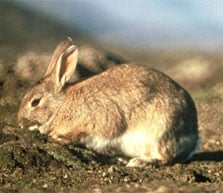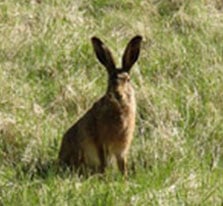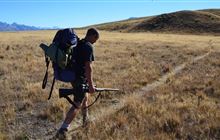Rabbits and hares
Introduction
If you wish to hunt rabbits and hares, you will need to obtain a small game hunting permit.Description

Rabbit
European rabbit
(Oryctolagus cuniculus cuniculus)
Size: Adults up to 2 kg.
Colour: Grey brown with paler underside. Infrequently black, ginger and silver-grey colours encountered. Eyes brown. Tips of ears narrow black rim.
Social behaviour: In high density populations rabbits live in a complex of underground burrows (warren's) and in lower numbers above ground cover. Home range about 1 ha.
Reproduction: Timing, litter frequency and size dependent on habitat conditions with productivity as high as 45 to 50 kittens (young rabbits) per year in good areas, down to around 20 in poorer areas, average litter five. Kittens are born blind in underground burrows and emerge at about 3 weeks old.
Gestation period: 30 days.
Birthing: Most months although frequently not March to May.

Brown hare
Brown hare
(Lepus europaeus occidentalis)
Size: Adults up to 4.8 kg.
Colour: Mottled black and fawn on upper surface with tawny sides. Belly is pure white. Eyes yellow. Ears black patch at the tip.
Social behaviour: Hares solitary with large 50 ha or more home ranges.
Reproduction: Leverets (young hares) are born above ground fully covered in a thick coat of pile hair and with open eyes. Average litter size 2 with 4 litters per year.
Gestation period: 42 days.
Birthing: July to April.
Nomenclature:
Rabbits: Male = buck. Female = doe. Young = kit.
Hares: Male = buck. Female = doe. Young = leveret.
Where to hunt rabbits and hares
The Department of Conservation (DOC) has limited opportunities for hunting rabbits and hares. Contact the DOC office nearest the hunting area about opportunities and permit requirements etc.
Much of the suitable habitat is on private land and you need permission from the landowner.
European rabbit
Distribution: Rabbits occupy most suitable habitat in New Zealand from the coast to 1000 m in the South Island and to above the bushline in the North Island. Although less abundant than they used to be rabbits are still plentiful in Central Otago, the McKenzie Basin, North Canterbury and Marlborough.
Habitat preference: Ideally an annual rainfall of less than 1000 mm with light soils, sunny aspect and good cover close to feeding grounds. Favoured habitats include coastal dunelands, dry stony riverbeds, limestone hills and sunny coastal faces.
Brown hare
Distribution: Hares can be found throughout the North and South Islands of New Zealand occupying suitable habitat from sea level to 2000 m. Areas where hares are not found include parts of South Westland, Fiordland and an area from Auckland north about 80 km.
Habitat preference: All kinds of grassland or open country. Favoured areas include coastal sand dunes, pasture, rush covered areas and clearings in scrub or forest.
Tips for hunting rabbits and hares
|
Characteristics/behaviour |
Hunting response |
|---|---|
General |
|
|
Small with thin skin and short fur. |
Small calibre rifles .22 rim fire (often with subsonic ammunition and suppressed rifles) or shotguns. Note: Hunting rabbits and hares on DOC administered land is subject to a "small game permit" which in some locations permits .22 rimfire and shotgun use that is not normally allowed. |
|
Active at night emerging from cover late afternoon or evening. |
Late afternoon until dark, when rabbits and hares out feeding, best time to hunt. Note: Spotlighting is not permitted on public conservation lands. |
European rabbit |
|
|
Rabbits spent most of the day resting under cover. |
Unless jump shooting, stake out likely areas in late afternoon until dark when rabbits will emerge from cover for feeding. |
Brown hare |
|
|
During daylight hours, hares spend much of their time crouched in an oval depression referred to as a form. |
When hunting, keep alert as hares will often break from the form just before being stood on. |
|
Hares will often clip vegetation with a characteristic 45o cut and leave the tip of the plant nearby. |
Plants clipped at 45o angle indication that hares visiting the site. |
|
Hare sign includes:
|
Hare sign indicator of hare presence and worth staking out or hunting through area. |
Hunting seasons and ballots
In New Zealand, there is no seasonal restriction to hunting rabbits or hares meaning generally they can be hunted throughout the year. There are however, instances where restrictions apply for specific reasons and periods when hunting is favoured.
Specific restrictions
- Some areas may be closed during periods of high fire danger or high public use.
- Not a common occurrence but an area may be closed on a temporary basis to enable research or other management to be undertaken without being compromised by hunting.
It is important to check for these conditions with the DOC office nearest the hunting area.
Favoured hunting periods
- Hunting for rabbits and hares can be successful at any time.
Permits
If you wish to hunt rabbits and hares on public conservation land, you will need to obtain a small game hunting permit from DOC.
It restricts hunting of rabbits and hares (which are unprotected game animals) to specific areas and times.
The permit (if areas are available) can be obtained from the DOC office nearest the hunting area.
International travel with hunting trophies
You may need CITES documentation to enter or leave New Zealand with your hunting trophy.

